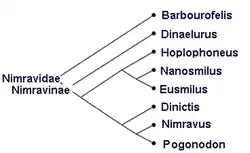Nimravinae
The Nimravinae are a subfamily of the Nimravidae, an extinct family of feliform mammalian carnivores sometimes known as false saber-toothed cats. They were endemic to North America, Europe, and Asia from the Middle Eocene through the Late Miocene epochs (Bartonian through Tortonian stages, 40.4—7.2 mya), spanning about 33.2 million years.[1] Centered in North America, the radiation of the Nimravinae from the Eocene to Oligocene was the first radiation of cat-like carnivorans.[2]
| Nimravinae Temporal range: | |
|---|---|
 | |
| Dinictis skeleton from South Dakota, displayed at the Royal Ontario Museum, Toronto | |
| Scientific classification | |
| Domain: | Eukaryota |
| Kingdom: | Animalia |
| Phylum: | Chordata |
| Class: | Mammalia |
| Order: | Carnivora |
| Suborder: | Feliformia |
| Superfamily: | †Nimravoidea |
| Family: | †Nimravidae |
| Subfamily: | †Nimravinae Cope, 1880 |
| Genera | |
|
†Dinictis | |

Nimravidae cladogram
References
- PaleoBiology Database: Nimravinae, basic info
- Bryant, Harold N. (1996). "Nimravidae". In Donald R. Prothero and Robert J. Emry (ed.). The Terrestrial Eocene-Oligocene Transition in North America. Cambridge, England: Cambridge University Press. p. 468. ISBN 0521433878.
This article is issued from Wikipedia. The text is licensed under Creative Commons - Attribution - Sharealike. Additional terms may apply for the media files.